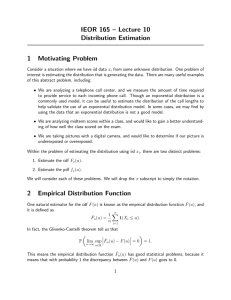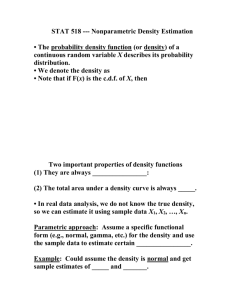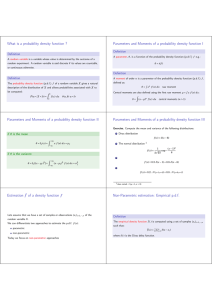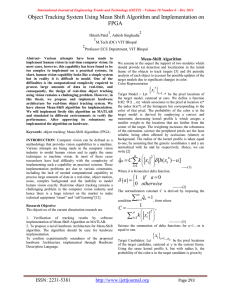IEOR 165 – Lecture 19 Kernel Estimation 1 Challenge with Density Estimation
advertisement
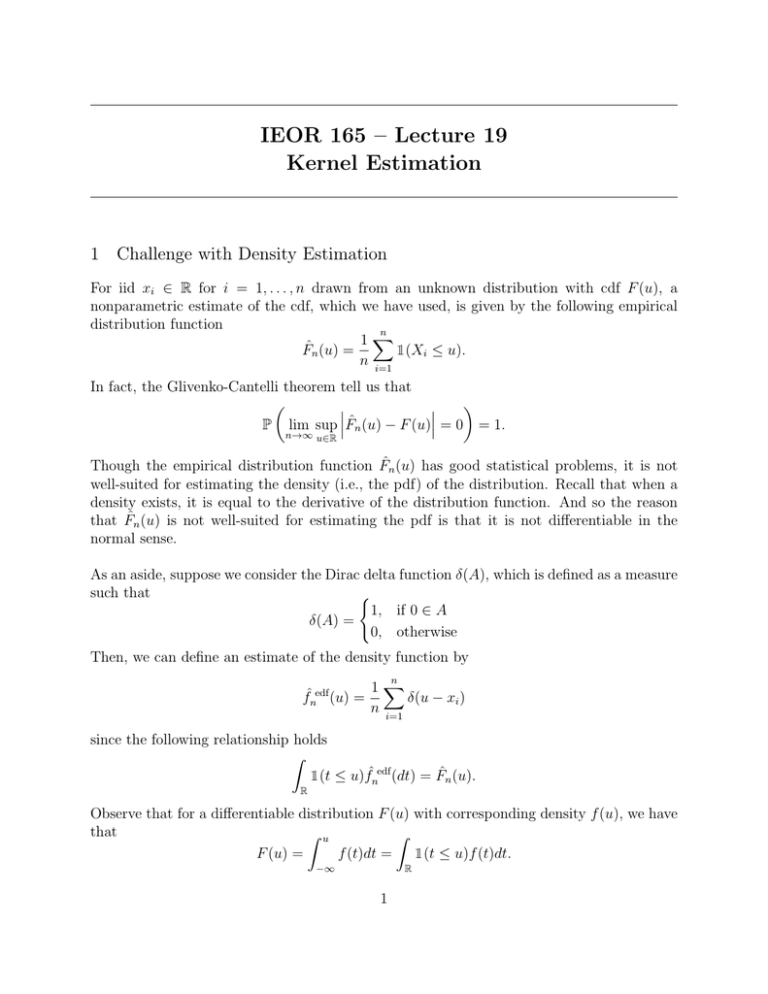
IEOR 165 – Lecture 19
Kernel Estimation
1 Challenge with Density Estimation
For iid xi ∈ R for i = 1, . . . , n drawn from an unknown distribution with cdf F (u), a
nonparametric estimate of the cdf, which we have used, is given by the following empirical
distribution function
n
1∑
F̂n (u) =
1(Xi ≤ u).
n i=1
In fact, the Glivenko-Cantelli theorem tell us that
(
)
P lim sup F̂n (u) − F (u) = 0 = 1.
n→∞ u∈R
Though the empirical distribution function F̂n (u) has good statistical problems, it is not
well-suited for estimating the density (i.e., the pdf) of the distribution. Recall that when a
density exists, it is equal to the derivative of the distribution function. And so the reason
that F̂n (u) is not well-suited for estimating the pdf is that it is not differentiable in the
normal sense.
As an aside, suppose we consider the Dirac delta function δ(A), which is defined as a measure
such that
{
1, if 0 ∈ A
δ(A) =
0, otherwise
Then, we can define an estimate of the density function by
1∑
fˆnedf (u) =
δ(u − xi )
n i=1
n
since the following relationship holds
∫
1(t ≤ u)fˆnedf (dt) = F̂n (u).
R
Observe that for a differentiable distribution F (u) with corresponding density f (u), we have
that
∫ u
∫
F (u) =
f (t)dt =
1(t ≤ u)f (t)dt.
−∞
R
1
So we can interpret the fˆnedf (u) as a derivative of the non-differentiable F̂n (u). However,
there is a problem with using this fˆnedf (u) as an estimate of the density. It essentially places
all the density mass at points where the data xi has been measured; the density is zero at
every other point on the real line. This is not a good estimate of the density because if we
know that our unknown density is continuous, then we would rather have an estimate that
interpolates between measured data points.
2 Histograms
The simplest estimate of the density is instead a histogram. The idea of a histogram is to
1. begin by specifying a support for the distribution, meaning specifying the range over
which the density is non-zero; suppose we specify that the support is [u, v];
2. next specify a set of bins partitioning the support, meaning specifying a set of strictly
increasing values b0 = u < b1 < . . . < bN = v that start at u and end at v;
3. we count the number of data points falling into each bin; specifically, we define
Cj =
n
∑
CN =
1(bj−1 ≤ xi < bj ),
i=1
n
∑
for j = 1, . . . , N − 1
1(bN −1 ≤ xi ≤ bN ).
i=1
4. finally, we define our histogram estimate of the density by
Cj
n(bj −bj−1 ) , if bj−1 ≤ u < bj
his
fˆn (u) = n(b C−bN ) , if u = bj
N N −1
0,
otherwise
Note that instead of specifying the edges of the bins b0 , . . . , bN , we could have instead specified
the desired number of bins N and set the bin edges to be bj = u + j · (v − u)/N .
3 Kernel Density Estimation
3.1
Motivation
Histogram estimates of the density f (u) are not continuous, and so it is interesting to consider
other approaches that produce continuous estimates of the density. One idea is to combine
the idea of a histogram with the density estimate (written in terms of Dirac deltas) that
2
was generated by differentiating the empirical distribution function. To start, recall that the
problem of the density estimate generated by the empirical distribution function
n
1∑
fˆnedf (u) =
δ(u − xi )
n i=1
is that it is zero at all points except the xi where data was seen. The next thing to note is
that the histogram works by giving width to counting the amount of data in some region;
the Dirac deltas were problematic because they give zero width to counting data in some
region.
3.2
Kernel Function
Given these two ideas, a proposal for another approach to estimate the density is to give the
Dirac deltas some width by replacing them by copies of a kernel function K(·) : R → R that
has
• finite support: K(u) = 0 for |u| ≥ 1;
• even symmetry: K(u) = K(−u);
• positive values: K(u) > 0 for |u| < 1;
∫
• unit integral: R K(u)du = 1.
Furthermore, we would like to be able to specify the width of the copies of the kernel
functions. We will use the variable h to denote bandwidth, and note that the function
1
K(u/h) has
h
• support over [−h, h];
• even symmetry h1 K(u/h) = h1 K(−u/h);
• positive values h1 K(u/h) > 0 for |u| < h;
∫
• unit integral: R h1 K(u/h)du = 1;
• maximum value of
1
h
maxu K(u).
An important conceptual point is that
h → 0.
1
K(u/h)
h
weakly converges to a Dirac delta when
It is interesting to consider some examples of kernel functions. The table below lists some
common examples:
Kernel Function
Uniform
Triangular
Epanechnikov
Quartic/biweight
Equation
K(u) = 12 1(|u| ≤ 1)
K(u) = (1 − |u|)1(|u| ≤ 1)
K(u) = 43 (1 − |u|2 )1(|u| ≤ 1)
15
K(u) = 16
(1 − |u|2 )2 1(|u| ≤ 1)
3
3.3
Estimate
The corresponding estimate of the density is then given by
1
fˆnkde (u) = fˆnedf (u) ∗ K(u/h),
h
where the symbol ∗ denotes a convolution. Recall that a convolution of two functions f, g is
defined as
∫
f (x) ∗ g(x) =
f (τ ) · g(τ − x)dτ.
R
In our context, we can simplify the convolution integral, which results in the following
equivalent equation for the density estimate
1 ∑
fˆnkde (u) =
K
nh i=1
n
(
u − xi
h
)
.
The kernel density estimate naturally generalizes to higher dimensions:
(
)
n
∥u − xi ∥
1 ∑
kde
ˆ
fn (u) =
K
,
nhd i=1
h
where d is the dimension of the random variables (i.e., xi ∈ Rd ).
4
